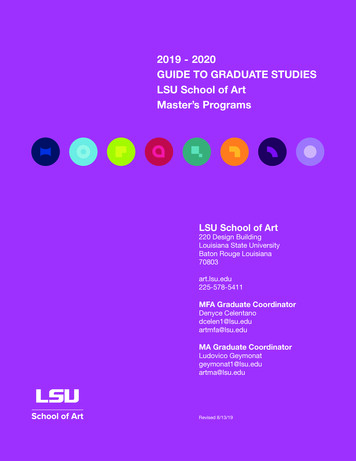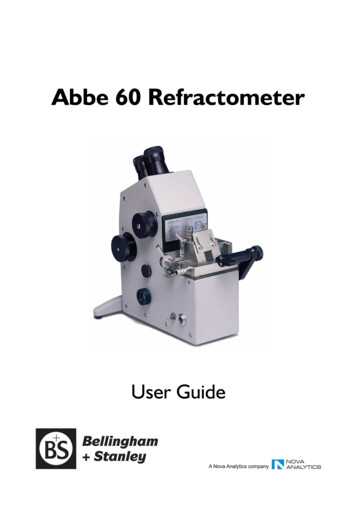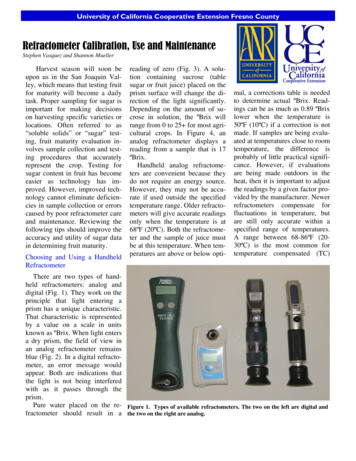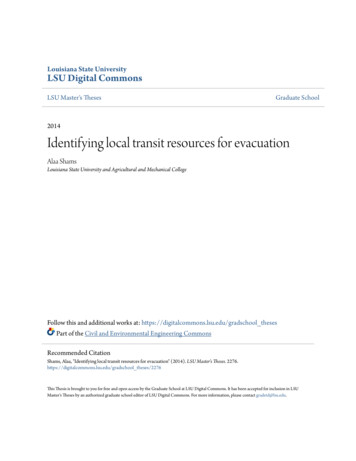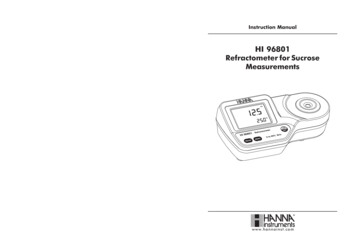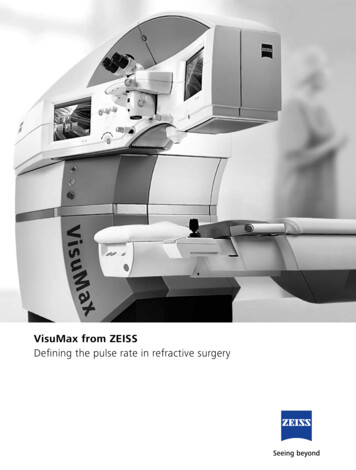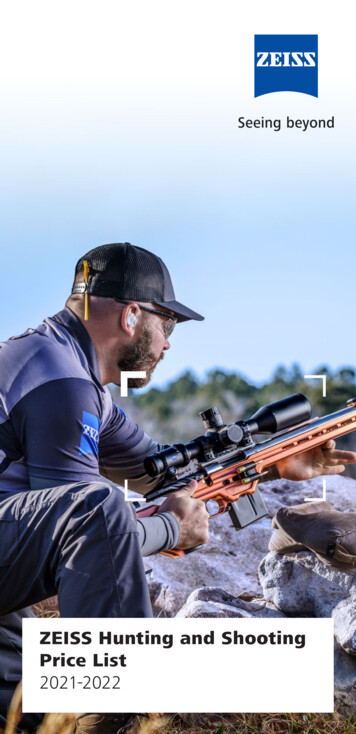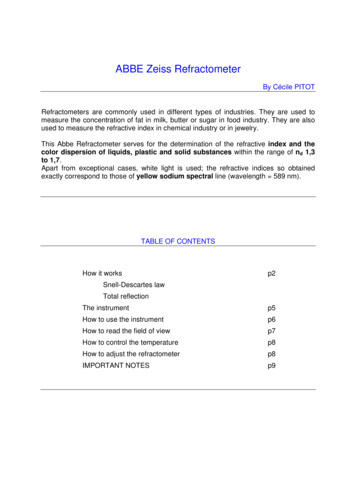
Transcription
ABBE Zeiss RefractometerBy Cécile PITOTRefractometers are commonly used in different types of industries. They are used tomeasure the concentration of fat in milk, butter or sugar in food industry. They are alsoused to measure the refractive index in chemical industry or in jewelry.This Abbe Refractometer serves for the determination of the refractive index and thecolor dispersion of liquids, plastic and solid substances within the range of nd 1,3to 1,7.Apart from exceptional cases, white light is used; the refractive indices so obtainedexactly correspond to those of yellow sodium spectral line (wavelength 589 nm).TABLE OF CONTENTSHow it worksp2Snell-Descartes lawTotal reflectionThe instrumentp5How to use the instrumentp6How to read the field of viewp7How to control the temperaturep8How to adjust the refractometerp8IMPORTANT NOTESp9
HOW IT WORKSThe phenomenon by which the direction of the light is modified after passing through anoptic medium is called the refraction. It comes from a change of propagation velocity ofthe light. The refractive index n characterizes the propagation velocity of a medium anddepends on temperature, concentration and pressure.n propagation velocity of the light in the vacuum / propagation velocity of the light inthe mediumSnell-Descartes lawIn the diagram below, two media of refractive indices n1 (on the left) and n2 (on the right)meet at a surface or interface (vertical line). n2 n1, and light has a slower phasevelocity within the second medium.Pn1n2θ1Oθ1Qn2 n1A light ray PO strikes the interface at the point O. From point O, we project a straight lineat right angles to the line of the interface; this is known as the normal to the surface(horizontal line). The angle between the normal and the light ray PO is known as theangle of incidence, 1.The ray continues through the interface into the medium on the right; this is shown asthe ray OQ. The angle it makes to the normal is known as the angle of refraction, 2.Snell's law gives the relation between the angles 1 and 2:n1 sin(θ1) n2 sin(θ2)Note: Snell's law is only generally true for isotropic media. In anisotropic media such assome crystals, birefringence may split the refracted ray into two rays, the ordinary or oray which follows Snell's law, and the other extraordinary or e-ray which may not be coplanar with the incident ray.2
Total reflectionAs we can see in the expression above, the angle of a ray passing from a medium with ahigh refractive index to a medium with a weak refractive index (n1 n2) is increased. As aconsequence, an angle (θ1lim) exists from which there is no more refractive ray. It is thetotal reflection. The refractive angle is equal to 90 .θ2 90 sin(θ2) 1 sin(θ1) n2/n1 θ1lim arcsin (n2/n1)n1n2θ1 limn1 n2This phenomenon is used in the refractometer.According to the principle of reverse return of the light, the ray passing from a mediumwith a weak refractive index (solution index ns) to a medium with a higher refractiveindex (prism index np) comes from the angle of incidence equal to 90 .With this grazing incidence, the refractive angle is:θ2 lim arcsin (nS/nP)As we can see on the figure below, all rays are refracted in a region defined between thenormal and θ2 lim. θ2 lim defines the limit between the bright area (refracted rays) and thedark area (no refracted ray) in the prism P.solutionIprismθ2 lim3
But to read this value (θ2 lim) we need glasses and an eyepiece. So the rays have to passthrough another interface: prism / air. The direction of the ray is thus modified.Let’s call θ’1 lim, the angle of the ray in the prism, θ’2 lim, the angle of the ray in the air andA, the point angle of the prism.nP sin(θ'1 lim) sin(θ'2 lim) (air index 1)θ'1 lim A - θ2 limsin(θ'2 lim) nP*sin(A - arcsin(nS / nP))nS nP*sin(A - arcsin( sin(θ'2 lim) / nP)solutionIprismAθ2 limθ’1 limθ’2 lim4
THE ting prismWindow for scale illuminationMeasuring prismMirrorLight admission aperture(closed)Locking of adjusting screwCompensator knobKnob for adjusting boundarylinesEyepieceConnection for the supply oftempering waterConnection for circulation oftempering waterConnection for circulation oftempering waterConnection for discharge ofthe tempering water5
HOW TO USE THIS INSTRUMENT1- Place a few drops of sample on the polished surface of the measuring prism (3)which must be entirely covered. Avoid bubbles.2- Bring the illuminating prism (1) into contact to the measuring prism (3)Note for rapidly vaporized solutions: the illuminating prism is merely lifted by the closingknob sufficiently to permit the liquid to be pipetted into the funnel-shaped opening of anarrow channel in the mount of the illuminating prism. The instrument should be slightlytilted during this operation.3- Orient light entrance apertures (2, 4, 5) toward a window or an artificial light.4- Open the right apertures and adjustHighly transparent and light coloredsubstancesTransmitted light Open (5)Open closely (4)Dark, heavily colored, plastic substancesand solid bodiesReflected lightbecause of their light absorption Close (5) Fully open (4)Bring the dark field from below towards Bring the dark field from above towardsthe middle of the field of view by turning the middle of the field of view by turningthe big knob (8):the big knob (8):Eliminate the colored border between The borderline is color-freedark and bright by turning thecompensator knob (7)5- Read the index line in the lower part of the field of the view (see p7) (refractiveindex or sugar percents).Concerning solid bodies:Solid bodies are measured in reflectedlight or in light with “grazing incidence”.The samples are placed only on themeasuring prism; the illuminatingprism is swung upward.6
The solid sample to analyze must have at least a plane and polished surface. There aretwo different procedures:One polish surface(non-translucent bodies)Reflected light Put a droplet ( 1mm diam.) ofhighlyrefractiveliquid(monobromine-naphtaline nd 1,66) on the polish surface Place this surface on themeasuring prism Follow previous instructions forreflected lightNote: if the sample does not cover theentire surface of the measuring prism,mask the measuring prism by a blackpaper cover.Two polished surfacesat right angle one to another with asharply defined intersectionGrazing transmitted light Adjust the light source to directlyadmit the light from the front(parallel to the surface of themeasuring prim). A piece oftransparentpaperinterposedbetween light source and prismusually considerably improvesoutline and adjustment of theboundary line. Open (4) Put a drop of intermediate liquidon the largest polished surface Place this surface on themeasuring prism and the secondpolished surface in front of theilluminating prismHOW TO READ THE FIELD OF VIEW1- Unscrew the eyepiece to its limiting stop2- Turn the knurled ring of the eyepiece untilthe crosshairs are clearly defined in theupper illuminated field of view.The upper field of viewBy turning the big knob (8), put the borderlinebetween bright and dark on the crossline in theupper field of view of the eyepiece. If the contrastThe lower field of viewThe lower field of view has two scales: the upperto read the refractive index for yellow sodium lightand the lower to read the dry substance percents(percentage of sugar in aqueous sugar solution).7
HOW TO CONTROL THE TEMPERATUREAs it is mentioned in “How it works”, the refractive index depends on temperature. So,measurements have to be made at a definite temperature.This ABBE Refractometer (Model B) can be used up to 200 C (ATTENTION: this ispossible only if the sample does not damage the prism cement layer even at hightemperaturze). The prisms of the refractometer are tempered by running water.Connection to thermostat: see “The instrument”.IN: upper nipple of the illuminating prismOUT: nipple on the other side of the measuring prism (thermometer side)Maximum rate (heating or cooling): 1 C/minNOTES: There is a difference between value indicated on the thermometer and actualtemperature of the sample.Operational temperature40 C60 C100 C120 C Sample temperature1 2 3 4 Wait until the temperature is stabilized before reading the refractive index.HOW TO ADJUST THE REFRACTOMETERThe procedure is the same as for measurement of liquids in transmitted light.Distilled water (very high purity) and its following table are used. 3341,3333 3281,3327 3211,3320If the mean value of several carefully effected determinations of the refractive index at agiven temperature does not deviate from the values given in the table by more than 2units of the 4th decimal, the adjustment may be considered sufficiently accurate.If there is deviations of the refractive index from table values, adjust by removing thecover on the right side of the instrument and re-setting the adjustment screw.8
For the average dispersion and the Abbe index, see the original manual.IMPORTANT NOTES Avoid hot samples on cold measuring prism and cold samples on hot measuringprism (danger of cracking).Take care to mix efficiently the sample, especially for viscous substances.Solid, undissolved particles do not influence measurement but may have adisturbing effect. It is expedient therefore to keep away from the measuring prism.Clean the surfaces of the prism with dust-free linen provided either dry ormoistened with an appropriate solvent until they shine.All pictures come from the original instruction manual.9
This ABBE Refractometer (Model B) can be used up to 200 C (ATTENTION: this is possible only if the sample does not damage the prism cement layer even at high temperaturze). The prisms of the refractometer are tempered by running water. Connection to thermostat: see "The instrument". IN: upper nipple of the illuminating prism
